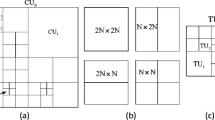Abstract
In this paper, we propose a fast-mode decision algorithm for both intra and inter prediction in depth videos. The proposed algorithm can reduce the computational complexity of the depth video coding. According to the depth variation, depth video can be classified into depth-continuity and depth-discontinuity regions. From experiments, we determine a threshold value for classifying these regions. Since the depth-continuity region has an imbalance in the mode distribution, we limit the mode candidates to reduce the complexity of the mode decision process. Experimental results show that our proposed algorithm reduces the encoding time by up to 78 % and 97 % for the intra and inter frames, respectively, compared to JMVC 8.3, with negligible PSNR loss and bitrate increase.







Similar content being viewed by others
References
P. Benzie, J. Watson, P. Surman, C. Kopylow, H. Urey, I. Rakkolainen, K. Hopf, V. Sainov, A survey of 3DTV displays: techniques and technologies. IEEE Trans. Circuits Syst. Video Technol. 17(7), 1647–1658 (2007)
G. Bjontegaard, Calculation of average PSNR differences between RD-curves, Doc. VCEG-M33, April 2001
Joint Multiview Coding (JMVC) 8.3, garcon.ient.rwth-aachen.de, May 2010
J. Lee, H. Wey, D. Park, A fast efficient multiview depth image coding method based on temporal and inter-view correlations of texture images. IEEE Trans. Circuits Syst. Video Technol. 99, 1–4, (2011)
H. Oh, Y. Ho, H.264/AVC-based depth map sequence coding using motion information of corresponding texture video, in Lecture Notes in Computer Science, vol. 4319 (Springer, Berlin, 2006), pp. 898–907
Z. Peng, G. Jiang, M. Yu, Y. Si, F. Chen, Virtual view synthesis oriented fast depth video encoding algorithm, in International Conference on Industrial and Information Systems, July 2010, pp. 204–207
K. Shin, K. Chung, S. Chun, A fast mode prediction of multi-view video coding using region analysis, in 6th International Conference on Digital Content, Multimedia Technology and Its Applications, August 2010, pp. 87–90
G. Sullivan, T. Wiegand, Rate-distortion optimization for video compression. IEEE Signal Process. Mag. 15, 74–90 (1998)
M. Suzuki, M. Tanimoto, T. Fujii, View synthesis algorithm in view synthesis reference software 2.0 (VSRS 2.0), ISO/IEC JTC1/SC29/WG11 MPEG2009/M16090 (2009)
M. Tanimoto, N. Fukushima, T. Fujii, Y. Mori, View generation with 3D warping using depth information form FTV, in 3DTV Conference, May 2008, pp. 229–232
W. Whu, W. Jiang, Y. Chen, A fast inter mode decision for multiview video coding. Consumer Electronics, 689–694 (2011)
Acknowledgement
This work was supported by the National Research Foundation of Korea (NRF) grant funded by the Korea government (MEST) (No. 2011-0030822).
Author information
Authors and Affiliations
Corresponding author
Rights and permissions
About this article
Cite this article
Yoon, DH., Ho, YS. Fast Depth Video Coding Method Using Adaptive Edge Classification. Circuits Syst Signal Process 32, 803–813 (2013). https://doi.org/10.1007/s00034-012-9501-3
Received:
Revised:
Published:
Issue Date:
DOI: https://doi.org/10.1007/s00034-012-9501-3




